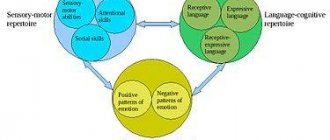BEHAVIORISM (from the English behavio[u]r - behavior), a branch of psychology limited to the study of behavior, which refers to bodily reactions to changes in the environment. Originated in the USA in the beginning. 20th century B.'s prerequisites were positivism and pragmatism in philosophy; studies of animal behavior (E. Thorndike and others); physiological and psychological the ideas of I. P. Pavlov and V. M. Bekhterev (primarily the concept of conditioned reflexes, which served as the natural scientific basis of B.); numerous applied problems that the introspective psychology that was dominant at that time could not solve.
B.’s “manifesto” is considered to be the article by its founder J.B. Watson “Psychology from the behaviorist’s point of view” (“Psychology as the behaviorist view it”, 1913, Russian translation 2002). Watson rejects the generally accepted method of introspection (self-observation) and any study of inner experience. Psychology must become natural. a science based on objective methods: experiment and observation of behavior. The concept of “consciousness” has no place in science. theories and research, since it is not amenable to external objective observation. Watson proclaims the subject of psychology. science of human and animal behavior, understood as the totality of all externally observable reactions of the body to external influences (stimuli). The unit of analysis of behavior in biology is the simplest “stimulus-response” (S-R) scheme; within its framework, all mental processes are considered. processes. The goal of biology is not only to study, but also to predict and change behavior: by studying the S–R connections, it is possible, based on the situation (combination of stimuli), to predict behavior (chain of reactions), and by changing these stimuli, it is possible to change it.
B. distinguishes between hereditary reactions (unconditioned reflexes, simple emotions) and acquired reactions (habits, thinking, speech, complex emotions, conditioned reflexes). In addition, reactions are divided into external and internal: external (speech, emotions, motor reactions, etc.) are open to observation with the naked eye, internal are accessible only to observation mediated by special reactions. devices (for example, thinking is considered in B. as hidden speech and bodily reactions).
The development of behavior (learning) consists of the acquisition of new reactions based on innate reactions to unconditioned stimuli through conditioning mechanisms. So, for example, in young children, a reaction of fear (freezing, then loud crying) can, according to Watson’s research, be caused by only two unconditional stimuli: a sharp sound and loss of support. Combining one of these stimuli with the presentation of, for example, a rabbit may result in the subsequent presentation of the rabbit alone causing a fear response.
B. was further developed in the “radical behaviorism” of B. F. Skinner. His concept of operant conditioning, in contrast to earlier versions of B., emphasizes the role of not only external causes of behavior, but also spontaneous manifestations of one’s own. activities of an individual that cause changes in the external environment. These physical changes and social environment have a reverse effect on the individual, increasing or decreasing the likelihood of repeated reproduction of behavioral reactions (operants) that caused these environmental changes. Thus, in the operant concept, the concept of “reinforcement” was able to be defined without explicit reference to subjective (represented in the consciousness of the actor) goals. Skinner's central thesis about the recursive interdependence of behavior and environment stated that the basis of meaningful behavior is the feedback between actions and their objective consequences.
The mechanism of biology and the denial of differences in the behavior of animals and humans (most experiments in biology were carried out on white rats, and their results were often transferred to humans) caused criticism from opponents of biology, which influenced the emergence of neobehaviorism. Until the 1960s B. and neobehaviorism were the dominant trends in Amer. psychology, having a significant impact on the theories and methods of teaching (see Programmed training), psychotherapy (see Behavioral psychotherapy), socio-psychological. concepts (see Social learning theory), etc., as well as philosophy of science, linguistics, anthropology, sociology, semiotics, cybernetics and other sciences. From the beginning 1950s under B.'s influence, the social sciences often began to be called the behavioral sciences.
What is behaviorism
This is Behaviorism / American Psychological Association direction of psychology, which studies only objective observable phenomena in human behavior (primarily reactions to stimuli), and not subjective ones such as feelings or consciousness.
According to behaviorism, the stimulus-response relationship determines all our actions and actions. This concept arose from the work of Russian biologist Ivan Pavlov on conditioned reflexes. Inspired by his work, psychologist John Watson wrote an article on the principles of behaviorism in 1913. The American suggested that Watson JB Psychology as the Behaviorist Views it / Psychological Review take a new look at a person through observable phenomena: stimuli, reflexes and instincts.
Since feelings, motives, consciousness and the mind cannot be studied experimentally, behaviorists consider them unknowable. They also oppose considering any internal experience, calling it subjective. The only thing that matters is Behaviorism / Stanford Encyclopedia of Philosophy is how a person reacts to the world around him, and not what he thinks about it.
So behaviorists wanted to give psychology more weight and transfer it to the category of natural sciences. And in many ways it worked out. For example, proponents of this approach were able to use mathematical and statistical methods, as well as confirm the results of experiments with repeated experiments.
In the wake of the rise of evidence-based science in the first half of the 20th century, behaviorism became very popular, especially in the USA.
Main theses and features of behaviorism
To better understand the ideas and methods of behaviorism, let's look at the main provisions of this direction:
- Behaviorism studies the behavioral responses of all living things;
- human actions are studied only by observing them;
- all mental, intellectual and physiological actions are dictated by behavior;
- all actions of living beings are a response to external triggers;
- if you determine the external stimulus in advance, you can guess the person’s further behavior;
- accurate prediction of behavior is the main goal of behaviorism;
- you can influence or control the behavior of any person;
- all behavioral reactions are acquired from experience or inherited from ancestors;
- skills are developed through reflexes, the ability to think or speak are acquired skills;
- the psyche of a living being is influenced by the environment and living conditions;
- emotions arise in response to positive or negative triggers in the environment.
The ideas of behaviorism, based on empirical experience, had a great influence on the scientific community. But any theory will always have both pros and cons. Let's look at them in more detail:
- Followers of behaviorism studied only external human reactions that were possible to observe. At the same time, they completely ignored the internal manifestations of a person: psychological and physiological processes.
- Scientists argued that it was possible to influence and control the behavior of any living creature. But they studied only the external simple reactions of a person; for them the complex actions of the individual as a whole did not matter.
- Behaviorists did not take into account the difference between animals and people; they studied their actions and behavior using the same methodology.
- When developing mechanisms of behavior, scientists did not additionally study important factors - society, motivation and mental image, which also influence human actions.
Behaviorists tried to characterize all human actions through one theory, but this approach was not successful. Man is a complex creature that needs to be studied from different angles. As a result, behaviorism was able to develop external conditions that can influence a person and encourage him to take certain actions.
If this information was useful to you, then go to the “Russia - Land of Opportunities” website. On the platform you will find more than 100 courses and webinars on marketing, psychology, management, finance and others. Make the most of your opportunities!
Why has behaviorism been criticized?
From the very beginning the approach was Behaviourism/New Philosophical Encyclopedia very limited. Behaviorism completely excluded the factor of heredity, ignored the role of thinking and decision-making processes, and did not consider the discoveries of neurobiology significant.
Representatives of the latter, for example, established Behaviorism / Stanford Encyclopedia of Philosophy that the areas of the brain that reinforce certain behavior do not coincide with the areas responsible for our pleasure. Therefore, even in animals, feeding does not always lead to learning new skills, or, more simply, training.
Behaviorists also believed that there were no differences in the behavior of humans and animals. This played a cruel joke on them, because most of their experiments were carried out by Sokolova E.E. Devyatko I.F., Leontiev A.A. Behaviorism / Great Russian Encyclopedia on rats, and the results extended to human behavior. Of course, this approach is not entirely scientific.
Therefore, today behaviorism in its pure form is practically not used Behaviorism / Stanford Encyclopedia of Philosophy.
Pros and cons of behaviorism
Any doctrine or system, no matter how harmonious they may seem, has its limitations in application, and over time, all the advantages and disadvantages of behaviorism became visible, where it would be appropriate to use the methods of this direction, and where it is better to use more modern methods. In any case, practitioners should not give up this wonderful tool in their practice and use the methods of behaviorism where it can give the best effect. Pros of behaviorism:
- everything that can be learned, studied and applied in behavior - behaviorism has fully and clearly demonstrated;
- direction, combined with a scientific theoretical approach, supported by vast practical experience, made it possible to expand psychology as a science;
- Behaviorism established the patterns of formation of behavioral skills.
Minuses:
- ignoring the participation of human consciousness, all behavioral skills are reduced to the mechanistic nature of reactions;
- motivation, will, the formation of a mental image of action, and self-reflection are also not taken into account by behaviorists;
- a person under experimental conditions is considered as an animal, with a set of instincts for survival;
- Behaviorism does not explain human desire for new inventions and creativity.
What Behaviorism Can Teach Us
Despite criticism, some of its provisions have not lost their relevance.
The environment greatly affects us
This principle today, when behaviorism is already more than 100 years old, remains one of the fundamental principles in psychology. Psychologists find sources of complexes, fears and worries in external causes.
The environment largely determines our actions. For example, one of the most famous behaviorists, Bernes Frederick Skinner, considered BF Skinner. Beyond Freedom and Dignity, that a person remembers the reaction of the environment to his behavior, and subsequently acts in one way or another depending on the possible consequences. That is, we learn which conditions lead to a positive outcome and which lead to a negative one, and we act accordingly. Therefore, if you want to remain yourself, do not forget to analyze your actions: whether you really did what you wanted, and whether there were any third-party factors.
People's behavior can be influenced
Behaviorists overly absolutized the idea of external influence on human behavior and practically denied the role of the individual. For example, they stated that under completely controlled conditions they could raise a child to be anyone they wanted. At the same time, his innate abilities, inclinations and desires should not have much significance.
Today we know that this is not so. For example, children in orphanages are brought up in approximately the same social conditions, but still have different characters.
Nevertheless, there is some truth in the views of behaviorists. For example, through intrusive advertising, marketers can 1. R. Sama. Impact of Media Advertisements on Consumer Behavior / Journal of Creative Communications 2. L. Uusitalo. Advertising and consumer behavior / Consumer Behavior - a Nordic Perspective to shape our desire to purchase a product. In essence, this is a slightly more complex “stimulus-response” relationship: the hero of the commercial repeatedly calls to buy the product, and we begin to think about the need for it. So you need to be more attentive to such thoughts - it is quite possible that such expenses are not so necessary.
You need to fight not the consequences, but the cause of psychological problems
The focus on finding the source of problems, rather than correcting the consequences, was adopted by cognitive scientists. Cognitive behavioral therapy is based on this principle. It helps a person change their habits, behavior and thoughts so as not to experience negative psychological effects. For example, worries about other people's behavior.
Reward works, but punishment doesn't work very well.
Rewards reinforce certain behaviors, while punishment discourages them. This is exactly how the school grade system works.
However, behaviorists have offered a slightly more complex view. Skinner wrote BF Skinner. Beyond Freedom and Dignity, that the carrot is more important than the stick. The psychologist believed that reward best stimulates a person, and punishment does not turn people away from bad deeds, but only forces them to look for other ways to do them. For example, learn to lie. Therefore, if you want to develop good habits in yourself or someone else and minimize bad ones, use praise more actively.
Behaviorism in sociology
was perceived in the version of B.F. Skinner, especially in terms of his methodological. reflections and reasoned criticism of the concepts of “autonomous man”, “internal homunculus”, in which these metaphors were asserted as the root cause of human activity. In his opinion, these concepts are associated with an erroneous interpretation of humanism as self-sufficient individualism, which is based on the opposition of human freedom and dignity to the determinism and naturalism of the “science of behavior.” They proceeded from the assumption that the internal (mental) causes of human actions are directly related to free will. In other words, psychic. reasons received a certain moral advantage in comparison with the external conditions of action. But with the help of references to the desires and beliefs of the invisible “inner man” it is impossible to explain or predict real behavior, it can only be described in other terms. B.'s appeal in Skinner's version to the cause-and-effect relationships of people's actions with their material and social environment opened up prospects for social engineering and scientific research. designing social practices and institutions (as well as the possibilities for manipulating behaviorist technologies of social control).
Skinner's version of B. was developed in sociology. theories of exchange, primarily in the neo-behaviourist theory of social exchange by J. C. Homans, as well as in the concepts of P. M. Blau, R. M. Emerson (1925–82, USA), J. S. Coleman and others. To identify patterns social interaction at the interpersonal and intergroup level, the laws of behaviorist psychology were applied to a situation where the external environment becomes a specific “social environment” - another person (or group), and the participants in the interaction, who have different resources, “reinforce” each other not only materially, but also social benefits, including praise, attention, money, services, concessions.
Directions of behaviorism
Attention! Followers of behaviorism felt the inadequacy of this approach. The explanation of the work of human consciousness did not fit into the standard “stimulus-response” scheme. There was a need to introduce a motivational element into behavioral patterns.
As a result, behaviorism split into several directions:
- Cognitive behaviorism, founded by E. Tolman. The researcher added the intermediate link “cognitive activity” to the traditional “stimulus-response” scheme.
- Goal behaviorism is the argumentation of behavior by the goal facing an animal or person. For example, a number of studies have clearly illustrated that rats run through a maze because they are hungry, driven by hunger. The purpose of their behavior is to find food.
- Social behaviorism suggests taking into account one’s social experience when studying a person’s response to a particular situation.
The origins of behaviorism occurred in the 19th century. The original methodological foundations of this approach cannot be taken for work in an unchanged form. However, today the achievements of this psychological school are used in psychoanalysis, political science and management.
Behaviorism in management










